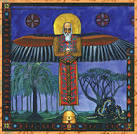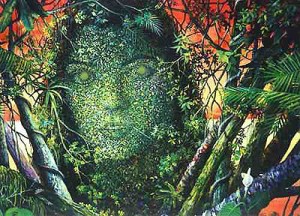DEPTH IN ANY DIRECTION:
Imagination as the Door
In the previous blog on “DEPTH AND THE MEDICINE OF THE HEART, PART 1,” I mentioned my conception of depth as not confined to the downward direction alone, as James Hillman richly, and usefully made it appear to us in his wonderful book, “The Dream and the Underworld.” If you could stand in space, at the center of the galaxy or the universe, you would probably come to understand that there are inexhaustible depths in any direction whatsoever, beyond what your feeble eyes allow you to see. We speak of deep space. We could stand on a comet and get a sense of vast spatial depth in any direction. With inward inquiry, we can find inexhaustible depths beyond the surface appearance of things within our own consciousness, and the beliefs and interpretations we give to those depths. To deepen our knowledge of depth, and not automatically go downward into subconscious or subterranean zones, we have to shift our language, to words and metaphors that shift our capacity to discover, feel into, and envision depths in any direction. Saying that “deep down” we really want, or feel, or think ‘…’ leaves us tied to thinking derived from physical space, and depth = downward.
Of course there are many situations in which ‘deep down” works well, as a metaphor for our experience of depth (when it feels deep down). But you can raise your head and look into the depths of the night sky. With a Native American medicine wheel, each cardinal direction, as well as above and below, and within has depths, mysteries, and powers beyond their surface appearances. So we need a language of depth for all those other directions, for any direction whatsoever. This would support our capacity to “see” (as in being a “Seer”) and “see through” as Hillman wanted us to be able to do, from an event to its image. We might even be able to sense the entity presenting itself in or as this image. We can then see behind, beyond, above, within, as well as below the surface appearances. Where Hillman privileged the downward (in what he called “soul”), and distrusted and therefore marginalized the “upward” in importance (what he called “Spirit”), we can give due importance to all directions, without need to privilege any single direction at the cost of others.
Hacking from the Depths
Other metaphors can shift the way we see things in depth. Whether we use the modern depth psychological language of the unconscious, or the shamanic word “Nagual,” from indigenous Mexico, there is something from the depths that we can say hacks into the surface world of appearances when we are sleeping (dreams of the night), and through our symptoms and conflicts, our problems, or spontaneous psycho-spiritual emergence, as well as those amazing synchronicities that come unbidden, from time to time. I am borrowing the metaphor of “hacking into” from popular language of people who gain unauthorized access to data bases and other forms of information. “Hacker,” in the context I am using it implies an other, an agent or person or entity who is doing the hacking. The “Dream Maker,” Jung’s personification of whatever agency sends us dreams of the night without asking your permission. It just does it. We don’t ask for disturbing dreams or troubling symptoms to come, they just do.
There are exceptions. If we take a powerful plant medicine like ayahuasca, or engage on a holotropic or sacred breathwork session, we are making an intention, an invitation to the self-healing (holotropic) forces within our depths to hack-in through the firewall of our defenses, surface beliefs, and repressions. We are asking to enter the space of dreaming conscious, to move into the Dreamtime for purposes of insight, healing, or transformation. Sometimes we do it out of curiosity, unaware of the painful truths that will suddenly surface. We may not at all like what comes, we may be expecting something else, and we may not like having to face this stuff rooted in the raw, the painful, and the all too truthful. So we can be hacked into from the depths, or we can, ourselves, also hack into them intentionally, and unawares.
The Purest Form of Imagination
Dreaming is the purest form of imagination, says Jungian analyst Robert Bosnak. I think he is right. In dreaming our imaginations are wild, untamed, and freely shifting and dripping with emotion and bodily responses. The “Land of Dreaming” is a vast, surreal space. Images of great artistry, beauty, ugliness, attended by fascination or horror are spontaneously and generously produced. Many dreams seem compensate a one-sided point of view, as C.G. Jung pointed out. Some come with revelatory power, offer insight, or creative problem resolutions, like Einstein, Kekule’, and Jung also suggested. Yet other dreams seem to bring in the departed, the ancestors, or alien entities that have their own life, their own points of view, and who may be happy or surprised to encounter us. As dream researcher Robert Moss claims, the traffic in dreaming can be two-way. In entering the Dreamtime we enter pure imagination, and there are figures there trying to say something to us; often something we need to take into account to be more wise, more whole, or more open to a cosmos we had imagined as too small and too closed for entities beyond what we believed could possibly be there.
It is difficult for us to grasp the openness to transpersonal others in Dreamtime because of our conditioned beliefs about the imagination. The Imagination has fallen on difficult times, in the Western world. For the ancient Greeks, dreaming brought the opportunity to meet transpersonal others, daimones or di-manes, gods, goddesses, the mythical beings coded in mythology, and folk lore. Until the Church Councils at Nicea (787 AD) and Constantinople (869 AD), with its desire to co-opt direct revelation made dreaming and imagination suspicious, the imagination was open to the spiritual, non-material dimensions where other entities could be encountered. In the ancient view, as in shamanism across cultures, a spiritual revelation through the Dreamtime meant discovering new ways of defining oneself and understanding the mysteries of the world. It means discovering new ways of defining oneself, and affected one’s actions in life. Revelation through dreams, like poetizing, involved an intrusion of new information, new points of view from encounters with numinous others. This was vital to traditional societies. A society lives or dies by its ability to be open to such breakthroughs. Through openness to the Dreamtime revelatory breakthroughs can reorder cognitive patterns, shift value-priorities, fire the imagination, raise motivation for creative change.
Unfortunately, this way of breakthrough to and from the depths of experience long ago became dangerous religious heresy, and imagination was reduced to nothing but made-up fantasies or “representations” of things in the subjective mind. It no longer was to be considered objective or revelatory of numinous others. This is the tradition we have now inherited, and which the recent revolution in psychedelic research and plant based shamanism is now challenging, as well as the challenges of Jungian and archetypal psychology. In Western history, images were reduced to surface appearances (representations in the mind) and no longer were the soul of things and beings (anima mundi) revealing themselves. In this way, the deeper depths and many-sidedness of things and reality was closed off from access, and so we have become conditioned to stay close to the surface appearances (in every direction).
The Church councils warned us that the imagination is so potentially sinful. Today modern psychiatry and psychology discourages us from exploring the realms of imagination too deeply, for we may lose our rationality, and even fall into madness itself. Thus through conditioning we are programmed to believe that it is dangerous to stray too far from social consensus beliefs that images are nothing but representations lacking in true revelatory power. If anything hacks into us from beyond, from the depths, it will be tamed, neutralized (by force if necessary) or by psychoanalytic reduction: it becomes tamed as just a projection of your own subconscious desire or conflicts.
C.G. Jung himself reports how he faced this tricky issue during his midlife crisis, those “Red Book” years when he went into the depths and engaged in dialogue with various entities and figures, the major one being a Gnostic looking entity with horns and wings, named “Philemon.” He concluded that Philemon was a force that was not-I:
…I held conversations with him, and he said things which I had not consciously thought. For I observed clearly that it was he who spoke and not I. He said I treated thoughts as if I generated them myself, but in his view, thoughts were like animals in the forest, or people in a room, or birds in the air, and added, “If you should see people in a room, you would not think that you had made those people, or that you were responsible for them.” It was he who taught me psychic objectivity, the reality of the psyche. ….He confronted me in an objective manner.
-Memories, Dreams, Reflections, p. 183
Interestingly here, Jung exhibits a skill long known to shamans across cultures. His method of dialogue with transpersonal others is very similar to the shamanic journey method. He called it “active imagination.” This kind of dialogic relationship, a back and forth with the numinous figures or entities that appear in the imaginal space of the Dreamtime, is also needed in plant based shamanism. Dialogic engagement with “Madre Ayahuasca,” with “Padre San Pedro, and other “spirit doctors,” and entities are as important as Jung’s encounters with Philemon. It is often vital to the cleansing, insighting, and healing, processes of plant based shamanic ceremonies…
If we want to open ourselves to the depths in every direction, we can begin by priming the pump. It really helps when we re-open our concept of the Imagination, and of the depths, so that in this openness we can once again begin to explore our capacities to connect us to the not-I, and help us communicate with the realities of numinous others, lurking in the depths. *
TO BE CONTINUED *
Note. My critique of Hillman’s identification of depth with the downward direction is based on the two volumes cited in the References below. I am a great admirer of his work, but I feel on this point, he created an unnecessary disjunct between high and low, soul and Spirit, and cut out the very possibilities of depth engagement he called “seeing through.”
References:
Robert Bosnak. Embodiment: Creative Imagination in Medicine, Art, and Travel.
- G. Jung. Memories, Dreams, Reflections. (Pantheon Books, 1961).
James Hillman. Peaks and Vales. Spring Publications. Puer Papers. 1979
James Hillman. The Dream and the Underworld. Harper Torch Books.
Ralph Metzner, ed,. Ayahuasca: Sacred Vine of Spirits. Rochester VT, Park Street Press
Robert Moss. DREAMGATES: Exploring the World of Soul, Imagination, and Life Beyond Death. New World Library.
- Michael Smith. “Depth and the Medicine of the Heart, Part I”
Blog: https://crowsnestshamanism.com/blog/depth-medicine-heart/
- Michael Smith. Jung and Shamanism in Dialogue: Retrieving Soul/ Retrieving the Sacred. Trafford Press, 2007. eBook: Amazon.com 2014.
- Michael Smith. Psychotherapy and the Sacred. Chicago: Center for the Scientific Study of Religion Press, 1995.
Paul Tillich. “The Depth of Existence.” A sermon in the volume entitled, The Shaking of the Foundations. New York. Charles Scribner and Sons. 1948






Oh, sorry, I misunderstood. you aren’t getting the news letter? In that case, if you just signed up, you will get it when it is published. That is to say, it isn’t automatic. I do one less than once per month, because of my travel schedule. You should get the next. 🙂
Thanks Kathleen. In your spam box, find the document from my website, highlight it, and find menu button that says “Not Spam”Click or double click on that. It should fix it.
Thank you for your words , you are teaching me well…Blessings.
p.s. Ive subscribed to your blog but it is just not coming into my in box or spam…any ideas ? Thank you kindly